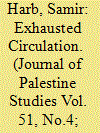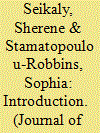|
|
|
Sort Order |
|
|
|
Items / Page
|
|
|
|
|
|
|
| Srl | Item |
| 1 |
ID:
189544


|
|
|
|
|
| Summary/Abstract |
This article looks at cement as a vital material in the process of urbanization. It specifically addresses urban metabolism, examining the intricacies of the cement circulation network in the occupied Palestinian territories (oPt) during the post-Oslo period. Because of Israel’s near-total control of land and natural resources in the oPt, there is still no fully integrated Palestinian cement plant there, making the Palestinian construction sector highly dependent on imports from Israel’s Nesher cement factory. This article argues that controlling the circulation of cement constitutes sovereignty over the processes of urbanization. In the current context, the cement circulation system that is effectively controlled by Israel is characterized by exhaustion, resulting in Palestinian urban geography’s perennial metabolic insufficiency.
|
|
|
|
|
|
|
|
|
|
|
|
|
|
|
|
| 2 |
ID:
189541


|
|
|
|
|
| Summary/Abstract |
The Journal of Palestine Studies’ special issue on infrastructure, environment, and health in Palestine sheds new light on the conditions and possibilities of politics. Although it is commonly viewed as “an entity ostensibly separate from technology and other human constructions,” the environment is in fact a particular configuration of “socio-technical arrangements.” The special issue’s four articles and two reflection essays—by Nadi Abusaada, Leena Dallasheh, Samir Harb, Cristina Violante, Nimrod Ben Zeev, and Emily McKee—span historical periods from Ottoman-ruled Palestine to the contemporary era. Hailing from the fields of history, architecture, anthropology, and legal theory, the contributors draw on original archival, spatial, and ethnographic research to parse the realities, experiences, and lessons that Palestine offers beyond its status as a site of settler-colonial deprivation and toxicity. Together they demonstrate that infrastructure, environment, and health are fundamentally and irrefutably political.
|
|
|
|
|
|
|
|
|
|
|
|
|
|
|
|
| 3 |
ID:
144171


|
|
|
|
|
| Summary/Abstract |
India’s post-liberalisation landscape has unexpectedly been populated by monumental iconic statues. These statues, co-emergent with an automobile and construction boom and an attendant resignification and revaluing of land, are a productive site for rethinking the role of spectacle in neoliberal globalisation from the locus of post-liberalisation India. Against theories that characterise spectacle as primarily virtual and deterritorialised, they illuminate how spectacle is enmeshed in the imaginaries, spatial politics, material processes and heterogeneous temporalities of uneven development. Their religious aspect also calls for a re-examination of Benjamin’s distinction between cult value and exhibition value.
|
|
|
|
|
|
|
|
|
|
|
|
|
|
|
|
| 4 |
ID:
125657


|
|
|
|
|
| Publication |
2013.
|
| Summary/Abstract |
Cement is the second largest anthropogenic emission source, contributing approximately 7% of global CO2 emissions. Carbon dioxide capture and storage (CCS) technology is considered by the International Energy Agency (IEA) as an essential technology capable of reducing CO2 emissions in the cement sector by 56% by 2050. The study compares CO2 capture technologies for the cement manufacturing process and analyses the economic and financial issues in deploying CO2 capture in the cement industry. Post-combustion capture with chemical absorption is regarded as a proven technology to capture CO2 from the calcination process. Oxyfuel is less mature but Oxyfuel partial capture-which only recycles O2/CO2 gas in the precalciner-is estimated to be more economic than post-combustion capture. Carbonate looping technologies are not yet commercial, but they have theoretical advantages in terms of energy consumption. In contrast with coal-fired power plants, CO2 capture in the cement industry benefits from a higher concentration of CO2 in the flue gas, but the benefit is offset by higher SOx and NOx levels and the smaller scale of emissions from each plant. Concerning the prospects for financing cement plant CO2 capture, large cement manufacturers on average have a higher ROE (return on equity) and lower debt ratio, thus a higher discount rate should be considered for the cost analysis than in power plants. IEA estimates that the incremental cost for deploying CCS to decarbonise the global cement sector is in the range US$350-840 billion. The cost estimates for deploying state-of-the art post-combustion CO2 capture technologies in cement plants are above $60 to avoid each tonne of CO2 emissions. However, the expectation is that the current market can only provide a minority of financial support for CO2 capture in cement plants. Public financial support and/or CO2 utilisation will be essential to trigger large-scale CCS demonstration projects in the cement industry.
|
|
|
|
|
|
|
|
|
|
|
|
|
|
|
|
|
|
|
|
|